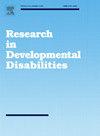巴西版DABS:基于内部结构的适应过程和有效性证据
IF 2.9
2区 医学
Q1 EDUCATION, SPECIAL
引用次数: 0
摘要
诊断适应行为量表(DABS)是一种美国标准化的工具,它提供了可靠和有效的信息来确定个人是否在适应行为方面有显著的局限性。本研究旨在开发巴西DABS的跨文化改编版本(DABS- b),并基于该改编的内部结构检验有效性证据。改编工作包括项目的翻译、委员会对翻译的整合、委员会对初步翻译的验证、研究组的调整、试点测试、测试后调整和最终版本测试。422名年龄在20 ~ 73岁之间的受访者(M=40.41;SD=8.12),他提供了477名年龄在4至21岁之间的巴西人的适应行为信息(M=10.31;SD = 4.35)。参与者包括临床组和非临床组。数据分析采用项目反应理论(IRT)。结果有力地证明了每个DABS-B域的单维性,表明该结构在两个域和年龄组中都是定义良好且一致的。良好的调整表明该措施的调整执行得很好。本文章由计算机程序翻译,如有差异,请以英文原文为准。
Brazilian version of the DABS: Adaptation process and validity evidence based on the internal structure
The Diagnostic Adaptive Behavior Scale (DABS) is an American standardized instrument that provides reliable and valid information to determine whether an individual has significant limitations in adaptive behavior. This study aimed to develop a transculturally adapted version of the DABS for Brazil (DABS-B) and examine the validity evidence based on the internal structure of this adaptation. The adaptation involved translation of the items, consolidation of the translation by a committee, validation of the preliminary translation by a committee, adjustments by the research group, pilot testing, post-test adjustments, and a final version test. The DABS-B was administered to 422 respondents aged between 20 and 73 years (M=40.41; SD=8.12) who provided information about the adaptive behavior of 477 Brazilians aged between 4 and 21 years (M=10.31; SD=4.35). The participants included clinical and non-clinical groups. Data analysis was conducted using Item Response Theory (IRT). Results provided strong evidence of unidimensionality within each DABS-B domain, suggesting that the construct is well-defined and consistent across both domains and age groups. Good adjustments indicated that the adaptation of the measure was well executed.
求助全文
通过发布文献求助,成功后即可免费获取论文全文。
去求助
来源期刊

Research in Developmental Disabilities
Multiple-
CiteScore
5.50
自引率
6.50%
发文量
178
期刊介绍:
Research In Developmental Disabilities is aimed at publishing original research of an interdisciplinary nature that has a direct bearing on the remediation of problems associated with developmental disabilities. Manuscripts will be solicited throughout the world. Articles will be primarily empirical studies, although an occasional position paper or review will be accepted. The aim of the journal will be to publish articles on all aspects of research with the developmentally disabled, with any methodologically sound approach being acceptable.
 求助内容:
求助内容: 应助结果提醒方式:
应助结果提醒方式:


